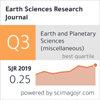层状土壤沉积物中的物质阻尼
IF 0.5
4区 地球科学
Q4 GEOSCIENCES, MULTIDISCIPLINARY
引用次数: 0
摘要
由于广泛使用一维等效线性分析来确定非线性土壤沉积物的自由场响应,因此能够重现等效线性代码的类似响应的动态数值模拟对于实际工程,特别是动力土-结构相互作用问题具有重要价值。对于不接近破坏条件的问题,一个有吸引力的替代方案是假设土壤的线性弹性行为,但采用一维等效线性分析得出的刚度参数,即与输入运动引起的变形水平一致。在这种方法中,能量耗散必须通过材料阻尼公式人为地纳入。在这项工作中,评估了FLAC中的局部、瑞利和滞后阻尼公式,以模拟一维等效线性分析的结果。分析的一个主要特点是,他们考虑了一个具有相当分层的土壤沉积物的地点,其中剪切波速剖面显示出显着的变化,并且在阻尼公式中选择一些参数不是一项微不足道的任务。结果为所采用的阻尼公式的性能和材料阻尼参数的选择提供了相关的见解,以再现等效线性分析的结果。本文章由计算机程序翻译,如有差异,请以英文原文为准。
Material damping in a stratified soil deposit
Due to the extensive use of one-dimensional equivalent linear analyses to determine the free-field response of nonlinear soil deposits, dynamic numerical simulations able to reproduce an analogous response to equivalent linear codes are of great value for practical engineering, particularly for dynamic soil-structure interaction problems. An appealing alternative, for problems not close to a failure condition, is to assume a linear elastic behaviour of the soil but with stiffness parameters derived from one-dimensional equivalent linear analyses, i.e. consistent with the level of deformation induced by the input motion. In this approach, energy dissipation has to be artificially incorporated through material damping formulations. In this work, local, Rayleigh, and hysteretic damping formulations in FLAC were assessed to emulate results from one-dimensional equivalent linear analysis. A main feature of the analyses is that they consider a site having a considerably stratified soil deposit, in which the shear wave velocity profile displays significant variations and where the selection of some parameters in the damping formulations is not a trivial task. Results provide relevant insights into the performance of the adopted damping formulations and the selection of material damping parameters to reproduce results of equivalent linear analyses.
求助全文
通过发布文献求助,成功后即可免费获取论文全文。
去求助
来源期刊

Earth Sciences Research Journal
地学-地球科学综合
CiteScore
1.50
自引率
0.00%
发文量
0
审稿时长
>12 weeks
期刊介绍:
ESRJ publishes the results from technical and scientific research on various disciplines of Earth Sciences and its interactions with several engineering applications.
Works will only be considered if not previously published anywhere else. Manuscripts must contain information derived from scientific research projects or technical developments. The ideas expressed by publishing in ESRJ are the sole responsibility of the authors.
We gladly consider manuscripts in the following subject areas:
-Geophysics: Seismology, Seismic Prospecting, Gravimetric, Magnetic and Electrical methods.
-Geology: Volcanology, Tectonics, Neotectonics, Geomorphology, Geochemistry, Geothermal Energy, ---Glaciology, Ore Geology, Environmental Geology, Geological Hazards.
-Geodesy: Geodynamics, GPS measurements applied to geological and geophysical problems.
-Basic Sciences and Computer Science applied to Geology and Geophysics.
-Meteorology and Atmospheric Sciences.
-Oceanography.
-Planetary Sciences.
-Engineering: Earthquake Engineering and Seismology Engineering, Geological Engineering, Geotechnics.
 求助内容:
求助内容: 应助结果提醒方式:
应助结果提醒方式:


